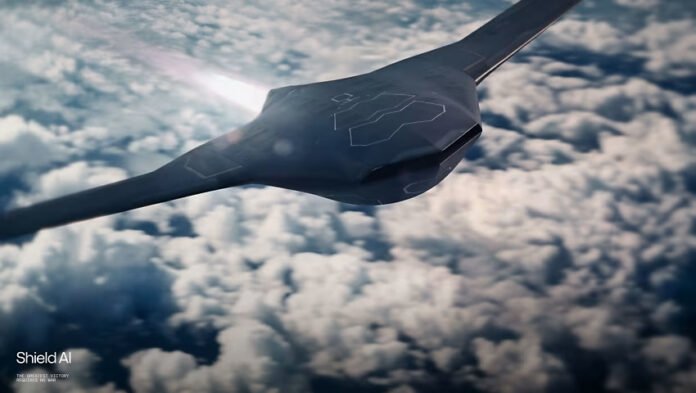New Delhi: In what could well change the concept of air power, the X-BAT completely reimagines airpower – from training and logistics to operations and operating costs. This marks the greatest transformation in military aviation since the first airplanes launched and landed from ships 115 years ago. X-BAT will serve as the leading edge of a distributed, unmanned fires network — capable of launching and recovering from ships, remote islands, or austere forward bases while eliminating dependency on traditional infrastructure.
Artificial intelligence startup Shield AI announced plans to expand further into the realm of military hardware, unveiling a new fighter-drone concept dubbed the X-BAT that the company plans to fly with its in-house autonomy software. The unmanned wingman is a Group 5 drone, Pentagon parlance for the largest of unmanned systems, that can take off and land vertically. Images released by Shield AI show testing with a large jet engine, along with a drone with sleek surfaces designed to reduce the system’s radar signature.
“It is truly an inspirational aircraft,” Shield AI President and Co-founder Brandon Tseng said during a curtain-raising event in Washington for the new drone, where a static display was shown to an audience of industry and government attendees.
While Shield is the designer of the system, company officials were open that a partner would be brought in to help actually produce the X-BAT, with Armor Harris, the head of the firm’s aircraft business unit, telling reporters that “we’ll be announcing our partnerships more in the coming weeks.”
Harris said the propulsion vendor the company is partnering with will be announced “in the coming weeks.” However, he described the X-BAT as operating with an “F-16 class engine” featuring an after burner and thrust vectoring nozzle that was “originally developed for a late 1990s F-15 thrust vectoring program.” He later told reporters that “multiple engine options [are] available.”
The X-BAT is being pitched as a “complete” system, Harris said, with the firm’s “Hivemind” computer pilot at the aircraft’s core to ensure the jet-powered drone can operate in communications-denied environments. The firm expects to execute “initial” vertical takeoffs and landings “as early as fall 2026,” with “all-up flight testing and operational validation” to follow in 2028, Harris said in written replies.
The company claims the X-BAT boasts a range of over 2,000 nautical miles, with an internal weapons bay and exterior hard points for munitions and a modular design that can swap in payloads for missions like surveillance or electronic warfare. The drone would take-off and land vertically using a launch-and-recovery vehicle, sharing similar features with Shield AI’s existing MQ-35 V-BAT drone but scaled up for a larger aircraft. Officials say they are planning for the X-BAT to be able to operate either independently or as a wingman to a manned platform.
The Navy, Marines Corps and now the Army have all expressed interest in unmanned concepts, though the services are at various stages. The Navy has awarded “conceptual” contracts to several vendors to design drones for carrier-based operations.
The company expects to start testing the new jet in 2026, it said, and aims to have it ready to fly in military operations in 2028. The X-BAT will have a range of more than 2,000 nautical miles with a full payload and is expected to cost about $1 billion to become “operationally capable,” the company said.
The effort is part of a larger Silicon Valley push to make smarter, AI-powered tools for the US military and its allies. It’s the second hardware product from the 10-year-old startup Shield AI, one of the most prominent US defence startups, last valued at $5.3 billion. Shield AI’s other products include a drone called V-BAT and software to control autonomous aircraft called Hivemind.
The company stressed that the vertical takeoff and landing, or VTOL, capabilities of the X-BAT would make it more versatile in wartime contests. “This breaks dependence from runways,” said Tseng, because it lets warfighters launch operations from virtually anywhere.
Tseng said Shield AI doesn’t have contracts in place with customers for the X-BAT, but said the company has had many conversations with people within the defence community about the need for such an aircraft. Shield AI is among dozens of startups spending billions in venture capital developing advanced military hardware without a guarantee from the US government that the military will buy it. Shield AI has spent the past 18 months developing the X-BAT. It will be controlled by the company’s Hivemind software, and is designed to function autonomously as either a drone wingman or as a standalone fighter jet.






